Ijraset Journal For Research in Applied Science and Engineering Technology
- Home / Ijraset
- On This Page
- Abstract
- Introduction
- Conclusion
- References
- Copyright
Achieving Excellence: A Guide to Identifying Suitable Land for Engineering Structures
Authors: Rutvij Patel
DOI Link: https://doi.org/10.22214/ijraset.2023.56155
Certificate: View Certificate
Abstract
The First step in planning any building architecture is land selection. Anyone who is unaware of the site selection procedure will run into a lot of difficulties. For instance, because there are no amenities nearby, people will not choose the building as a place to live, which could have an adverse financial effect on the builder. Additionally, if a builder does not know about the soil’s bearing capacity and choose a location where it is poor, the building’s lifespan will be shortened. To ensure that no one encounters these issues, the site selection process is described in detail in this document. This document discusses topics such as an earthquake prone area, ground conditions, soil bearing capacity, common facilities, etc.
Introduction
I. INTRODUCTION
The area of civil engineering that deals with the engineering behaviour of earth materials is known as geotechnical engineering, often known as geotechnics. To overcome its engineering issues, it applies the concepts of rock mechanics and soil mechanics. It also makes use of expertise in geophysics, hydrology, and other relevant fields of science. Military engineering, mining engineering, petroleum engineering, coastal engineering, and offshore construction all use geotechnical engineering. Engineering geology and geotechnical engineering share common knowledge bases. While engineering geology is a subfield of geology, geotechnical engineering is a specialist of civil engineering.
A. History
Soil has long been utilized by humans for a variety of purposes, including flood control, irrigation, graveyards, building foundations, and building materials. Ancient Egypt, Mesopotamia, the Fertile Crescent, and the early towns of Mohenjo Daro and Harappa in the Indus valley all have dykes, dams, and canals that date back to at least 2000 BCE in Fig. 1. These artifacts are proof of early activity related to irrigation and flood control. Structures were built and supported on organized foundations as cities grew. The ancient Greeks were notable for their work on strip-and-raft foundations and pad footings. However, until the 18th century, no theoretical foundation for soil design had been established, and the field relied more on experience than it did on science.
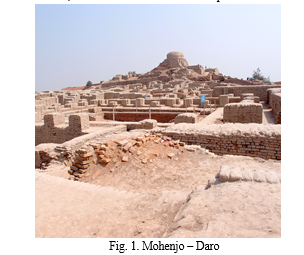
The development of earth pressure theories for retaining wall construction saw the initial advancements. The "natural slope" of various soils was identified by Henri Gautier, a French royal engineer, in 1717; this concept later became known as the soil's angle of repose.
The use of mechanical principles in soils dates to 1773, when Charles Coulomb, a scientist and engineer, devised more accurate ways to calculate the ground pressures against fortifications. The maximum shear stress on the slip plane, according to Coulomb, is the sum of the soil cohesion, c, and friction σ tan(Φ), where σ is the normal stress on the slip plane and Φ is the soil's friction angle. Coulomb observed that, at failure, a distinct slip plane would form behind a sliding retaining wall. Mohr-Coulomb theory was created by merging Coulomb's theory with Christian Otto Mohr's 2D stress state in Fig. 2. The Mohr-Coulomb theory was later given that name. The Mohr-Coulomb theory is still employed in practice today, even though it is now understood that accurate determination of cohesion is difficult since c is not a fundamental soil feature.

Darcy's Law, which describes how fluids move through porous medium, was created by Henry Darcy in the 19th century. The theories of stress distribution in elastic substances proposed by mathematician and physicist Joseph Boussinesq were successful in determining stresses at depth in the earth. Coulomb's earth pressure theory was challenged by engineer and physicist William Rankine. For the classification of soils, Albert Atterberg created the clay consistency indices still in use today. Osborne Reynolds discovered in 1885 that shearing results in the volumetric contraction of loose granular materials and dilation of solid materials.
According to legend, Karl von Terzaghi, a mechanical engineer, and geologist, published Erdbaumechanik in 1925, marking the beginning of modern geotechnical engineering. Terzaghi, who is widely regarded as the founder of contemporary soil mechanics and geotechnical engineering, created the concept of effective stress, and showed how it affects soil shear strength. Terzaghi also created the conceptual framework for ideas relating to the carrying capacity of foundations and the theory for forecasting the rate at which clay layers will settle because of consolidation. Maurice Biot later finished developing the three-dimensional soil consolidation theory, expanding Terzaghi's earlier one-dimensional model to encompass broader hypotheses and presenting the fundamental equations of poroelasticity.
Donald Taylor acknowledged that the soil's greatest strength was a result of the interlocking and dilatation of tightly packed particles in his 1948 book. The interrelationships between the volume change behaviour (dilation, contraction, and consolidation) and shearing behaviour with the theory of plasticity employing critical state soil mechanics were established by Roscoe, Schofield, and Wroth with the publication of On the Yielding of Soils in 1958. Many recent advanced constitutive models describing soil behaviour are based on critical state soil mechanics.
To disprove some of these expressions and make clear which expressions were appropriate considering various working hypotheses, including stress-strain or strength behaviour, saturated or non-saturated media, and rock, concrete, or soil behaviour, Alec Skempton conducted a thorough review of the formulations and experimental data that were available in the literature about the effective stress validity in soil, concrete, and rock in 1960.
B. Geotechnical Investigation
The characteristics of subsurface conditions and materials are investigated and determined by geotechnical engineers. Additionally, they plan corresponding earthworks, retaining walls, tunnels, and building foundations. They may also oversee and inspect sites, which could also entail risk analysis and the mitigation of environmental concerns.
To design the earthworks and foundations for proposed structures as well as to repair damage to earthworks and structures brought on by subsurface conditions, geotechnical engineers and engineering geologists conduct geotechnical investigations to learn about the physical properties of the soil and rock beneath and adjacent to a site. Geotechnical investigations entail both surface and subsurface study of a location, frequently including subsurface sampling and laboratory testing of retrieved soil samples. Geophysical techniques, such as electromagnetic surveys (magnetometer, resistivity, and ground-penetrating radar) in Fig. 3., surface-wave techniques, downhole techniques, and seismic wave measurements (pressure, shear, and Rayleigh waves) in Fig. 4., are also sometimes employed to gather data.

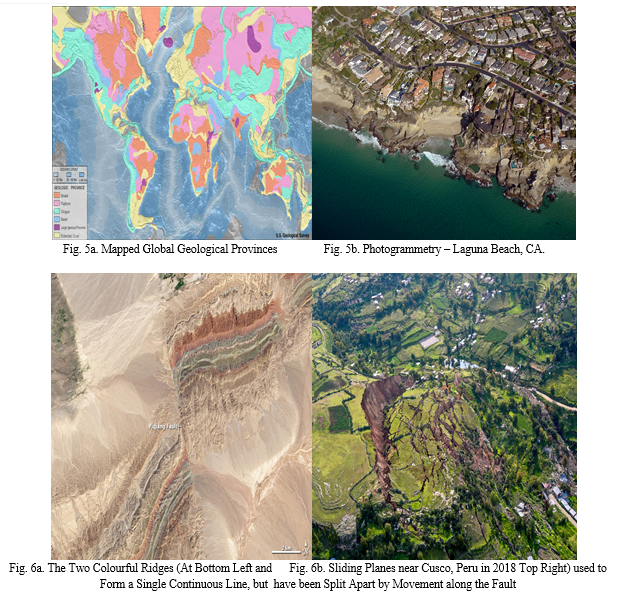
To fulfill the requirements of various engineering projects, a range of soil samples are available. The most popular method for obtaining disturbed samples is the conventional penetration test, which makes use of a split spoon sampler with a thick wall. For the collection of less disturbed samples, piston samplers with thin-walled tubes are most frequently utilized. Superior but more expensive techniques include the Sherbrooke block sampler. Any ground condition, including fill, sand, moraines, and rock fracture zones, can be sampled from frozen ground with high-quality, undisturbed results.
A further approach to testing physical scale models of geotechnical issues is geotechnical centrifuge modelling. Because soil's strength and stiffness are so sensitive to the confining pressure, using a centrifuge increases how similar the scale model experiments using soil are to each other. With the use of centrifugal acceleration, scientists may measure enormous (prototype-scale) stresses in tiny physical models.
II. PROCESS OF IDENTIFYING SUITABLE LAND FOR BUILDING
A. Site Analysis
It is important to do a through survey before buying a building site to determine whether the site’s attributes are appropriate for the development concept. A basic checklist is formed by the advice that follows:
- To identify nearby features, location, roads, amenities, footpaths, and rights of way, consult Ordnance Survey maps.
- Measure the place to determine its dimensions and levels.
- Pay attention to surface features, such as trees, steep slopes, existing structures, rock outcrops, and wells.
- Check with the local government to see if the site is subject to preservation orders and if it is a part of a conservation area.
- Investigate the subsoil. To ascertain the soil's condition and the depth of the water table, use trial holes and borings.
- Think about the possibility for flooding, the ability to drain the water table, the ability to cap springs, fill ponds, and divert streams and rivers.
- For information on subsurface and overhead services, their closeness to the site, and if they cross it, speak with local utility providers.
- Take note of any suspicious elements, including filled ground, ground fissures, subsidence from mining, and any building cracks.
- Considering the planned new development while considering the scale and style of the neighbourhood’s structures.
- Choose the ideal location for the structure (if there is room) considering "cut and fill," land slope, exposure to sun and weather conditions, practical use, and access.
B. Site Investigation
The primary goal of this kind of site investigation is to gather and record in a systematic manner all the information that will be required for or useful in the design and construction of the planned activity in Fig. 7. Plans and sections with the necessary annotations and dimensioning should be used to present the gathered data. Any information pertaining to the planned works that may have an impact on neighbouring sites, or vice versa, information pertaining to the proposed works that may have an impact on adjacent sites, should also be noted.
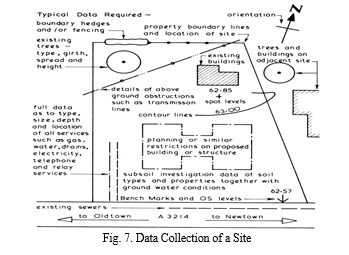
C. Soil Investigation
To the subsoil beneath the site being investigated and may or may not be included in the site investigation.
- Purpose of Soil Investigation
a. Ascertain whether the site is appropriate for the proposed project.
b. Choose a reliable and affordable foundation design.
c. Identify the potential challenges that may develop throughout the construction period.
d. Identify the incidence and/or reason behind any variations in the subsoil conditions.
The physical, chemical, and general characteristics of the subsoil can usually be determined by taking subsoil samples from locations on the site that are truly representative of the region but are not taken from the actual position of the proposed foundations. For most circumstances, a sequence of samples taken at the intersections of a 20000 square grid pattern should be sufficient.
2. Soil Samples
Samples of the soil can be taken either as disturbed or as undisturbed samples.
a. Disturbed Soil Samples
These soil samples came from test pits and boreholes. However, these samples are adequate for visual grading, determining the moisture content, and various laboratory tests even though the extraction procedure alters the subsoil's natural structure. Samples of disturbed soil should be kept in labelled, airtight jars.
b. Undisturbed Soil Samples
These are soil samples that were taken using coring equipment to retain the subsoil's natural structure and characteristics. The undisturbed soil samples that were taken are labelled and placed in wooden boxes before being sent to a facility for analysis. The rock and clay subsoils are good candidates for this approach of collecting soil samples, but it can be challenging to collect undisturbed soil samples in other subsoils.
The findings of soil sample tests are frequently displayed on a drawing that includes the locations of each sample as well as the results of the tests in the form of a hatching legend or section.
3. Depth of Soil Investigation
The depth to which the soil research should be conducted must be decided prior to choosing the actual method of obtaining the necessary subsoil samples. This is often determined by the following elements:
a. The suggested foundation style in Fig. 8.
b. The proposed foundation's pressure bulb in Fig. 9.
c. The proposed foundation's connections to other foundations in Fig. 10.
For all types of foundations, pressure bulbs that are less than 20% of the initial loading at the foundation level can be disregarded.
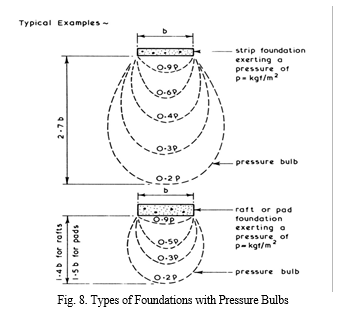

4. Soil Investigation Methods
The approach for soil investigation will be determined by several elements, including:
a. Size of contraction.
b. The suggested foundation's type.
c. The kind of sample needed.
d. The kinds of subsoils that could be found.
The following are generally considered to be the best approaches for deep investigation:
- Foundations up to 3.000 meter - trial pits in Fig. 11.
- Foundation borings that go down 30.000 meter in Fig. 12.
- Deep borings and in-situ investigations from tunnels and/or deep pits for foundations deeper than 30.000 meter.


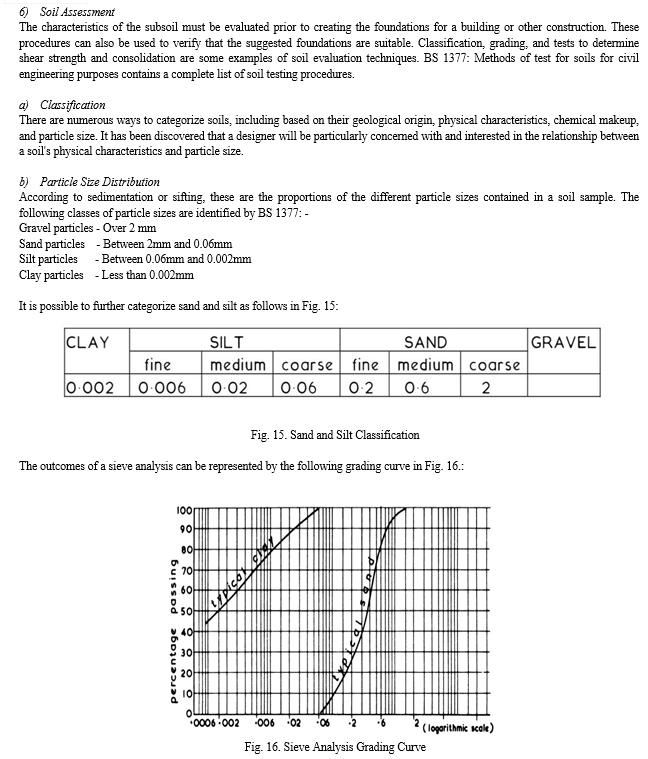
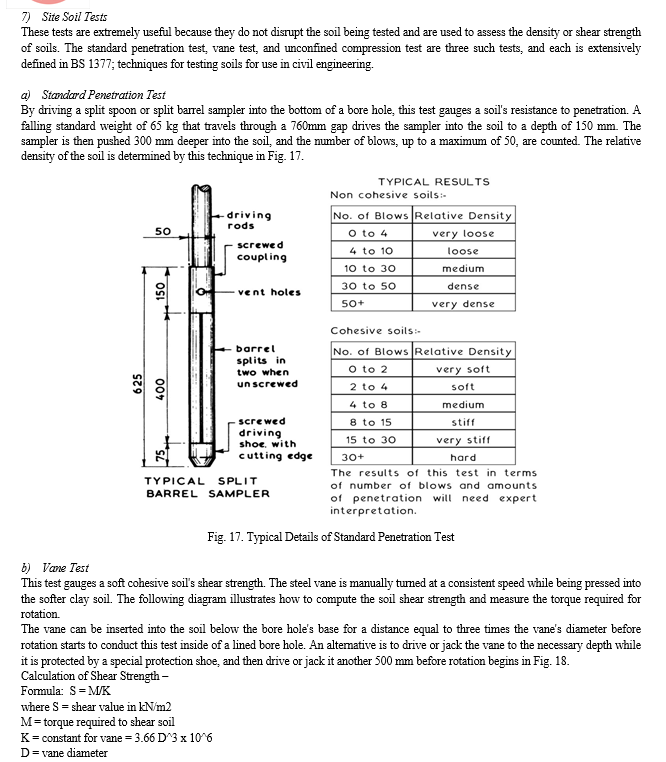
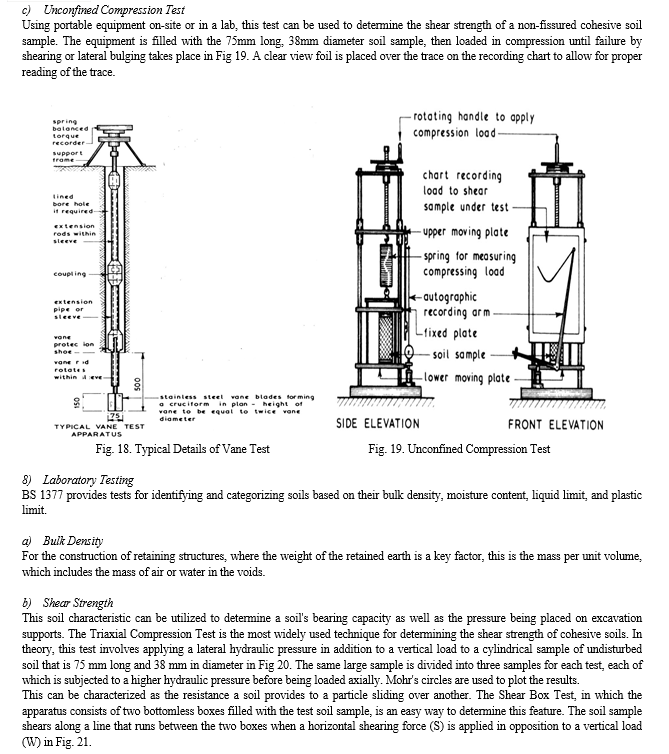
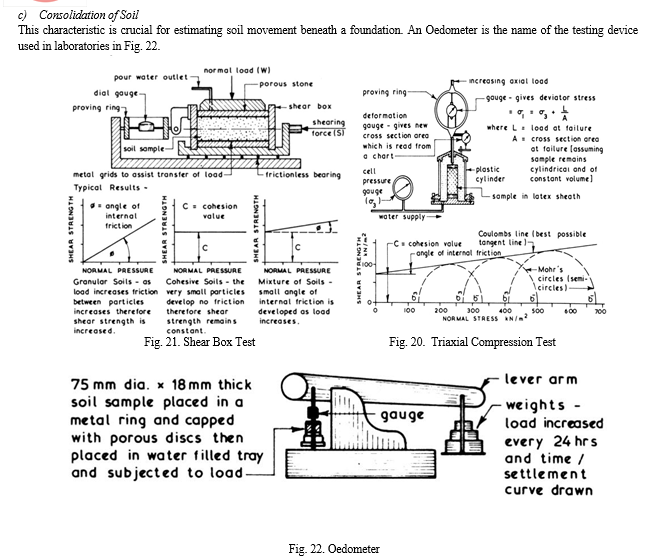
Conclusion
Poor site inspection can indicate several different things. It could be a symptom of bad survey design, under sampling, or a lack of flexibility to adapt to the conditions at the site; it could also indicate poor data gathering or processing techniques that provide incorrect results; it could also indicate results that are delivered too late to have an impact on the design. The results of inadequate site assessment can also range from the undesired, such as increased costs and building delays, to the catastrophic, such as structural collapse. A budget cut for the site research might increase costs later in the project in several different ways in addition to causing delays. First off, there is a chance that any money saved will later need to be doubled as the construction crew realizes the complexity of the ground and the necessity for additional research. Another element driving up costs is the over-engineering of foundations, which designers obliged to do to make up for a weak ground model when faced with high levels of uncertainty. In a similar manner, contractors will manage higher levels of risk related to ambiguity by adding a larger \"comfort blanket\" to account for the lack of information. The idea of choosing the right land is thoroughly explained in this document so that readers will not have to deal with any issues of this nature.
References
[1] Holtz, R. and Kovacs, W. (1981), “An Introduction to Geotechnical Engineering”, Prentice-Hall, Inc. ISBN 0-13-484394-0. [2] T. William Lambe and Robert V. Whitman, “Soil Mechanics”, Massachusetts Institute of Technology, John Wiley & Sons., 1969. ISBN 0-471-51192-7. [3] Bowles, J. (1988), “Foundation Analysis and Design”, McGraw-Hill Publishing Company. ISBN 0-07-006776-7. [4] Thomas Heahan (2010), “An Introduction to Geotechnical Engineering”, Pearson – 2nd Edition, ISBN 0-13-249634-8. [5] John B. Burland (2012), “A Brief History of The Development of Geotechnical Engineering”, Imperial College London, UK. [6] Structures Data Book, Cambridge University – Engineering Department, 2018. [7] Fiona Cobb (2014), “Structural Engineer’s Pocket Book: Eurocodes”, CRC Press – 3rd Edition, ISBN 0-08-097121-6. [8] J. Paul Guyer (2019), “Geotechnical Engineering Series: An Introduction to Engineering Properties of Soil (Geotechnical Engineerin”, Independent Published, ISBN 1-09-257329-1.
Copyright
Copyright © 2023 Rutvij Patel. This is an open access article distributed under the Creative Commons Attribution License, which permits unrestricted use, distribution, and reproduction in any medium, provided the original work is properly cited.

Download Paper
Paper Id : IJRASET56155
Publish Date : 2023-10-14
ISSN : 2321-9653
Publisher Name : IJRASET
DOI Link : Click Here
 Submit Paper Online
Submit Paper Online

